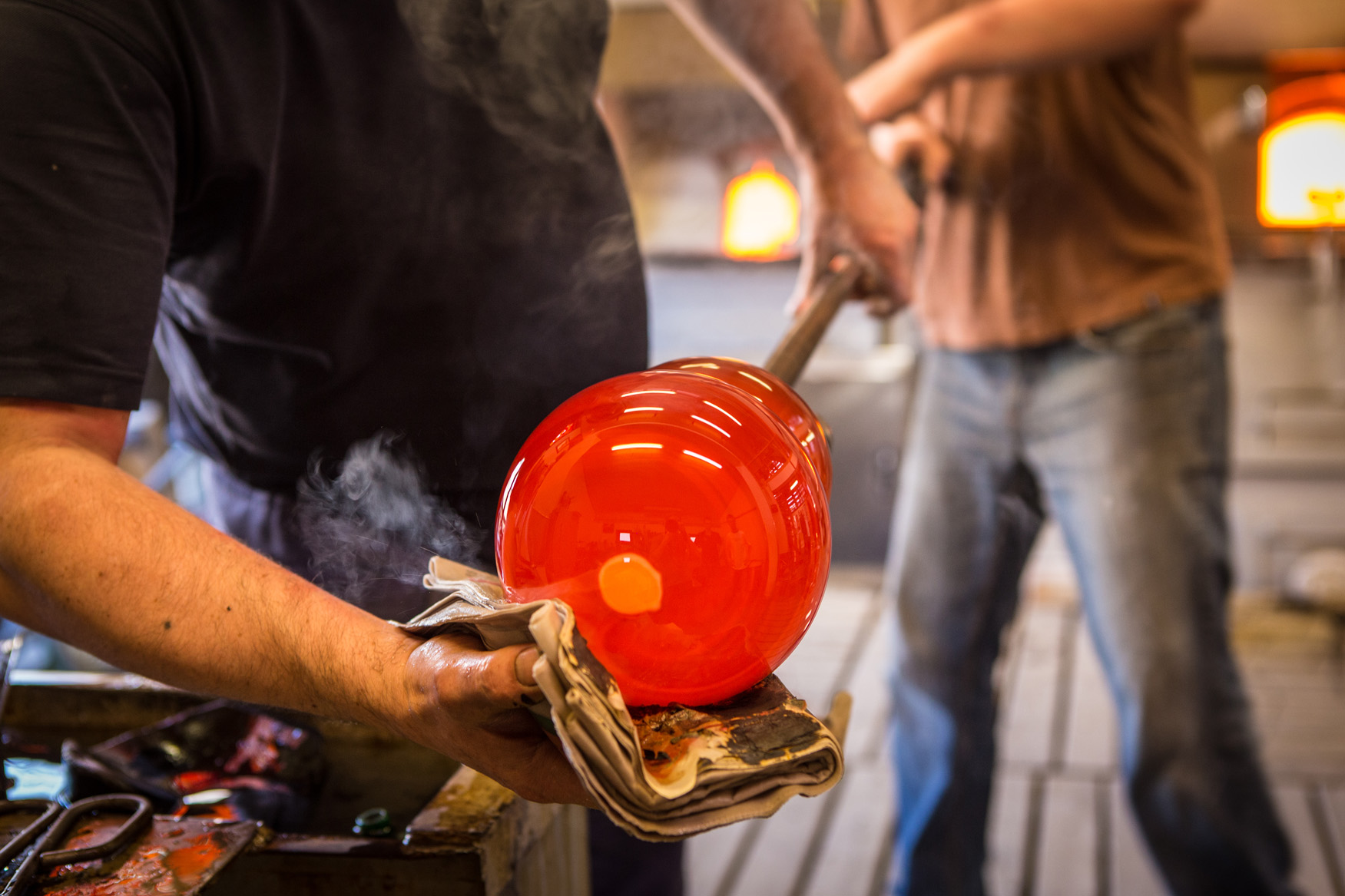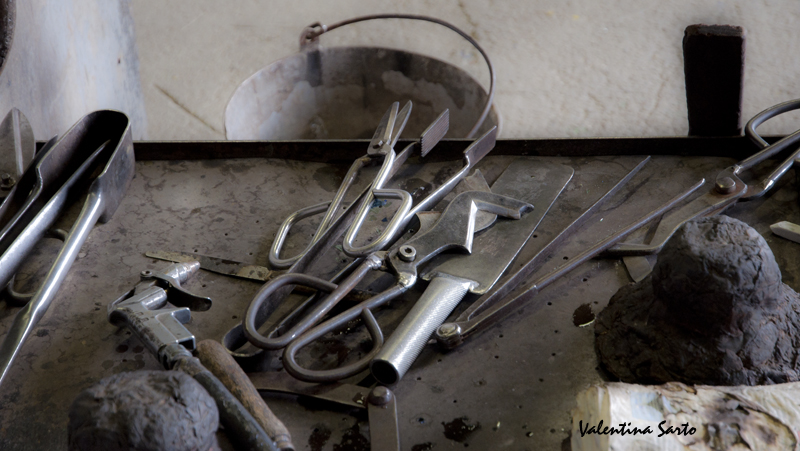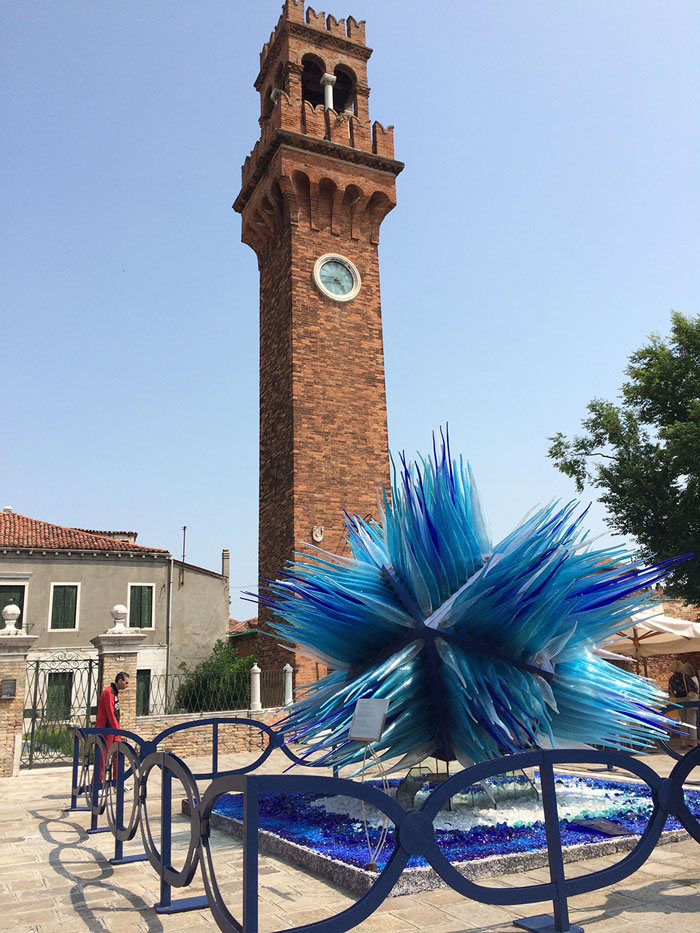Murano
MURANO
HISTORICAL NOTES
"Murano, the ancient AMURIANUM, the island of glass that faces, from the tramontana side, a short distance in front of Fondamene Nuove, Venice, and of this is almost a suburb, even today, as for centuries, daily in the quiet serenity of its gardens, of its houses, in the industrious silence of its furnaces it renews the always new and always wonderful miracle of its blown glass. ...
... Murano grew in prosperity and population, so as to reach its maximum splendor in the sixteenth century, when palaces and villas, vegetable gardens and gardens, churches and monasteries in large numbers had risen alongside the glassworks to denote the opulence of the rich community.
Squeezed in Venice, at the neighboring Dominante, by daily life and work relations, his people, however, was always jealous guardian of his own autonomy and Venice, who loved and protected the island made prosperous by its glass, came to grant her privileges and concessions, which are surprising when one considers the strict tradition of the Venetian government in preserving its prerogatives.
Murano was in fact able to enjoy a local administrative government, taking advantage of its ancient statutes 1272; he had a gold book to register his original families, who enjoyed special privileges, so that a Venetian patrician could marry a master glassmaker's daughter, without losing his titles of nobility at all; beer and police could not land on the island; like Venice, Murano could annually mint the "oselle", the coin medals, with the coat of arms of the current Doge, the Podestà and the Camerlengo of the island, were given as gifts to the main citizens.
The fortune and the richness of Murano were always linked to the continuity of his glass art, whose history and development is followed by visiting the collections of his VETRARIO MUSEUM.
... Murano grew in prosperity and population, so as to reach its maximum splendor in the sixteenth century, when palaces and villas, vegetable gardens and gardens, churches and monasteries in large numbers had risen alongside the glassworks to denote the opulence of the rich community.
Squeezed in Venice, at the neighboring Dominante, by daily life and work relations, his people, however, was always jealous guardian of his own autonomy and Venice, who loved and protected the island made prosperous by its glass, came to grant her privileges and concessions, which are surprising when one considers the strict tradition of the Venetian government in preserving its prerogatives.
Murano was in fact able to enjoy a local administrative government, taking advantage of its ancient statutes 1272; he had a gold book to register his original families, who enjoyed special privileges, so that a Venetian patrician could marry a master glassmaker's daughter, without losing his titles of nobility at all; beer and police could not land on the island; like Venice, Murano could annually mint the "oselle", the coin medals, with the coat of arms of the current Doge, the Podestà and the Camerlengo of the island, were given as gifts to the main citizens.
The fortune and the richness of Murano were always linked to the continuity of his glass art, whose history and development is followed by visiting the collections of his VETRARIO MUSEUM.

THE ART
OF GLASS IN MURANO
Watching the beauty of blown glass, small masterpieces of beauty and skill is always something that amazes and attracts. The art of the Master Glassmaker has something of the miraculous in it. With a simple glass rod, the master glassmaker removes from the "pans" (crucible) burning, immersed in the fiery furnace, a bolus of incandescent glass paste (800 -1.100 ° C); he has no model before him; only imagination and dexterity guide and help him. Bring the long barrel to the mouth and under the strain of the lungs the glazed vitreous paste swells, curves, dilates, takes the volutau shape: a spatula and a pincer (the ») Are his only instruments with which he squeezes, crushes, flattens bends, contorts the soft, fiery glass. Passed through a series of multi-faceted and patient operations, the small work of art emerges perfectly from the hands of the master and is placed together with all the work of the day within a long cooling tunnel called "ara", before leaving the smoky factory.
The oldest certain examples of Murano glass art that came to us only go back to the mid-1400s and are the cups, the large-surface glasses with strong ruby-red, deep blue, emerald green (famous in Venice the "Wedding Cup" of the Correr Museum) and in which the Barovier family became famous. But the true glory of the white, transparent blown glass, of the Venetian "crystal", came only instead affirming between the end of the XV and the princ. from the XVI century
All the most varied forms and the most diverse techniques were attempted: the iced glass, the lattimo glass or "lattisuol" (for the color of the milk taken from the opaque white paste) and the meshed or filigree glass from the "retortoli" , whose complicated technique gives the objects a unique appearance.
After a long period of loss after the fall of the Republic (1797), in the second half of the nineteenth century, the art of glass resurrected by the segacia and the will of ANTONIO SALVIATI.
They are the traditional names of the old Murano glassmakers, the BAROVIER, the TOSO, the FERRO, the SALVIATI, the FUGA, SEGUSO, RADI, all with their renewed industrious furnaces; later are the two groups of master glassmakers directed by VENINI and CAPPELLIN, in addition to other institutions more recently formed, to remember in this resumption of activity the studies of the mosaics and the large factories for the production of glass and crystal. In this renewed fervor, alongside the traditional types of Murano glass, a new production has emerged today with the most varied trends, the right expression of new artistic orientations.
From VENICE AND ITS ESTUARY of GIULIO LORENZETTI
The oldest certain examples of Murano glass art that came to us only go back to the mid-1400s and are the cups, the large-surface glasses with strong ruby-red, deep blue, emerald green (famous in Venice the "Wedding Cup" of the Correr Museum) and in which the Barovier family became famous. But the true glory of the white, transparent blown glass, of the Venetian "crystal", came only instead affirming between the end of the XV and the princ. from the XVI century
All the most varied forms and the most diverse techniques were attempted: the iced glass, the lattimo glass or "lattisuol" (for the color of the milk taken from the opaque white paste) and the meshed or filigree glass from the "retortoli" , whose complicated technique gives the objects a unique appearance.
After a long period of loss after the fall of the Republic (1797), in the second half of the nineteenth century, the art of glass resurrected by the segacia and the will of ANTONIO SALVIATI.
They are the traditional names of the old Murano glassmakers, the BAROVIER, the TOSO, the FERRO, the SALVIATI, the FUGA, SEGUSO, RADI, all with their renewed industrious furnaces; later are the two groups of master glassmakers directed by VENINI and CAPPELLIN, in addition to other institutions more recently formed, to remember in this resumption of activity the studies of the mosaics and the large factories for the production of glass and crystal. In this renewed fervor, alongside the traditional types of Murano glass, a new production has emerged today with the most varied trends, the right expression of new artistic orientations.
From VENICE AND ITS ESTUARY of GIULIO LORENZETTI

GLOSSARY OF MURANO GLASS WORKING
BATHROOMS
Wooden instrument to cool the rods to be raised, wetting them with water
BORSELLE
Iron pliers; they are the main tool in glass processing
PISSEGAR BAG
Pliers used to shape the glass
BRONZIN
Plate, in the past of bronze now of cast iron, serves to round, modify and prepare the pea before blowing or shaping
LEVAR OR SUPIAR ROD
Fundamental tool for glass processing, consisting of an iron pipe about 150 cm long, with which the glass is taken from the trough and work is carried out until the work is determined
CANE
Opaque or transparent glass rod
GIVE A HOT
Increase the temperature of the glass being processed, soften it, to allow the operator to shape it better
VITREI WIRES
Colored glass decorations applied to the glass object during processing
OVEN
Structure to melt the glass
FORSELA
Iron rod shaped like a fork at the end to be able to put on the hot glass object to insert it into the muffle
GROGIOLO
Container inside the oven in which the primary materials to obtain the glass are melted
IRIS
Treatment of the vitreous surface through exposure of the work to tin vapor
MAGIOSSO
Wood tool with a concave hemispherical shape, equipped with a handle that is used in the processing of the pèa
Moleria
Place for cold glass finishing, to cut and smooth it
FLASK
Glass annealing furnace
PEA
First glass ball taken from the trough to rough out and start the work
Sbruffo
Very thin layer of glass used as a decoration
SCAGNO
Wooden seat on which the master glassmaker works, equipped with two armrests on which the supiar or barrel rolled during the phases of processing of the work
TAGIANTE
Scissors used in processing the work to cut glass
TAGIOL
Iron scoop with sharp edges and wooden handle to mark the pea
Fundamental tool for glass processing, consisting of an iron pipe about 150 cm long, with which the glass is taken from the trough and work is carried out until the work is determined
CANE
Opaque or transparent glass rod
GIVE A HOT
Increase the temperature of the glass being processed, soften it, to allow the operator to shape it better
VITREI WIRES
Colored glass decorations applied to the glass object during processing
OVEN
Structure to melt the glass
FORSELA
Iron rod shaped like a fork at the end to be able to put on the hot glass object to insert it into the muffle
GROGIOLO
Container inside the oven in which the primary materials to obtain the glass are melted
IRIS
Treatment of the vitreous surface through exposure of the work to tin vapor
MAGIOSSO
Wood tool with a concave hemispherical shape, equipped with a handle that is used in the processing of the pèa
Moleria
Place for cold glass finishing, to cut and smooth it
FLASK
Glass annealing furnace
PEA
First glass ball taken from the trough to rough out and start the work
Sbruffo
Very thin layer of glass used as a decoration
SCAGNO
Wooden seat on which the master glassmaker works, equipped with two armrests on which the supiar or barrel rolled during the phases of processing of the work
TAGIANTE
Scissors used in processing the work to cut glass
TAGIOL
Iron scoop with sharp edges and wooden handle to mark the pea













